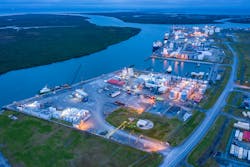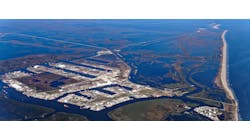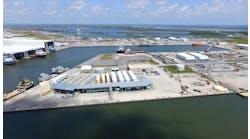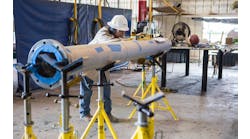Investment in products, processes improves service offerings
Judy Murray, Contributing Editor
The move into deepwater necessitated the development of capabilities and technologies that would be effective in this new and demanding operating environment. As the number of deepwater discoveries grew, companies began to develop products specifically designed to deliver drilling and production efficiencies to maximize productivity for deepwater wells.
These changing demands led to the development of new completion design philosophies and technologies and created a market for advanced completion fluids. TETRA Technologies is one of the companies that responded to the deepwater challenge, delivering innovation and technological leadership to address evolving industry needs.
Since its inception in 1981, TETRA Technologies has designed and manufactured fluids for use in well drilling, completion, and workover operations and today serves a global market that includes customers in the US, Latin America, Africa, Europe, Asia, and the Middle East. One of the most active markets is the Gulf of Mexico (GoM), which the company serves in part from its facility in Port Fourchon, where TETRA has been a tenant for 36 years, expanding its presence six times since first setting up shop.
Today, the TETRA site covers 250,000 sq ft (23,226 sq m) with 3,750 sq ft (348.4 sq m) warehouse capacity and enjoys 850 ft (259 m) of waterfront bulkhead with a 22 ft (6.7 m) water depth. There is a 185 cu ft/min air compressor on site as well as a 150-ton crane and two forklifts rated for 4 tons and 18 tons. Fluids can be loaded or unloaded simultaneously on two boats using 6-in. (16.2-cm) load lines flowing at 31.25 bbl/min and 4-in. (10.2-cm) load lines flowing at 12.5 bbl/min.
The full-service facility houses two covered 250 bbl clear brine fluid (CBF) blending pits, three 500-bbl covered blending pits, 66,000 bbl of fixed asset storage capacity and 9,000 bbl CBF staging tanks for pre-blending orders.
From this facility in Port Fourchon, TETRA delivers CBFs, chemical additives, lube oils, drill water, potable water and diesel fuel and provides complete crane services as well as blending, filtration and fluid reclamation services to the GoM.
According to Joey Detiveaux, TETRA offshore completion services and fluids regional manager for the US, TETRA boasts the largest fixed blending facility for completion fluids at the Port. This location, with its easy access to the GoM, is one of the biggest selling points, he says.
Being located at the port is an advantage because the Greater Lafourche Port Commission advocates for Port tenants. “They are very helpful in understanding what we need,” Detiveaux said. “Whatever they can do to help, they do.”
Completion fluids
TETRA is leveraging its position near Port Fourchon to provide GoM operators with advanced completion fluid systems.
Unlike mud, “which you can get a feel for,” Detiveaux said, “blending completion fluids is an art,” explaining that special requirements demand precise blending because different downhole drilling environments dictate specific performance characteristics.
In simple terms, completions fluids ensure a smooth transition between the reservoir drilling and the completion phases of well development. They are designed to effectively complete a well and initiate economically viable production flow.
In the early days, completion “brines” were used to displace drilling fluid. As the nature of drilling changed, new methods for well completion were introduced, and the need arose for more specialized fluids. This spurred the creation of completion fluids that were more advanced than the traditional brines. As completion technology advanced, there was a greater need for customized completion fluids that delivered superior effectiveness.
“This is where TETRA made a name for itself,” Detiveaux said, and continuing investment in R&D is producing more specialized fluids for the industry.
“Our TETRA CS Neptune completion fluids are a prime example,” he said, explaining that this versatile product family can be blended for use as completion, drill-in, packer, and workover fluids and, because of their components, do not require zero-discharge equipment.
These fluids were developed by TETRA to be environmentally friendly alternatives to traditional zinc-based fluids and a cost-effective alternative to fluids containing cesium formate. This is significant, Detiveaux pointed out, because cesium formate is not only expensive, it is nearing depletion, and zinc is a priority pollutant, meaning it is on the list of specific pollutants defined in the US Clean Water Act that includes heavy metals and specific organic chemicals.
The TETRA CS Neptune completion fluids product line, which includes both divalent and monovalent high-density fluids, are formulated without the use of undissolved solids, zinc, priority pollutants, or formate ions and can achieve the densities normally only achieved by either zinc bromide or cesium formate.
These fluids can lower operating cost and simplify logistics because they require no special mixing, handling, or storage at the rig site. Also, the neutral-to-alkaline pH reduces HSE risk, so they can be reclaimed for reuse.
The original fluid system in the TETRA CS Neptune completion fluids product line was formulated by the TETRA R&D group specifically for a deepwater GoM project and was developed and deployed in less than 18 months, Detiveaux noted. Successful use offshore led the customer to use TETRA fluids in four subsequent wells. “We continued to develop this family of fluids for the last five years, and we now offer related fluid chemistries at densities up to 17.5 lb/gal (2.10 sg).”
According to Detiveaux, the same objectives that led engineers to develop completion fluids that mitigate or eliminate impact on the environment is a driver for other programs.
Reclamation
Reducing waste is a focus for a lot of operators in the GoM, and at the Port Fourchon site, TETRA reclaims used fluids. TETRA is helping companies manage increasing completion fluids requirements by recycling, treating, and delivering optimized fluid for well operations.
“We’ve gotten really good at completion fluid reclamation work. The process returns the fluid to a salable state with no solids, no oil, and no contaminants,” he said. “It’s the same quality as the original fluid.”
According to Detiveaux, now that TETRA has achieved this objective, it is focusing on improvements, in particular, increasing productivity by finding ways to move fluid more efficiently.
Better products and better processes improve TETRA’s ability to serve its GoM customers from Port Fourchon, Detiveaux noted, pointing out that continuous improvement is the best way for the company to differentiate itself in a competitive market.
“We are always trying to get better at what we do,” he said. •




